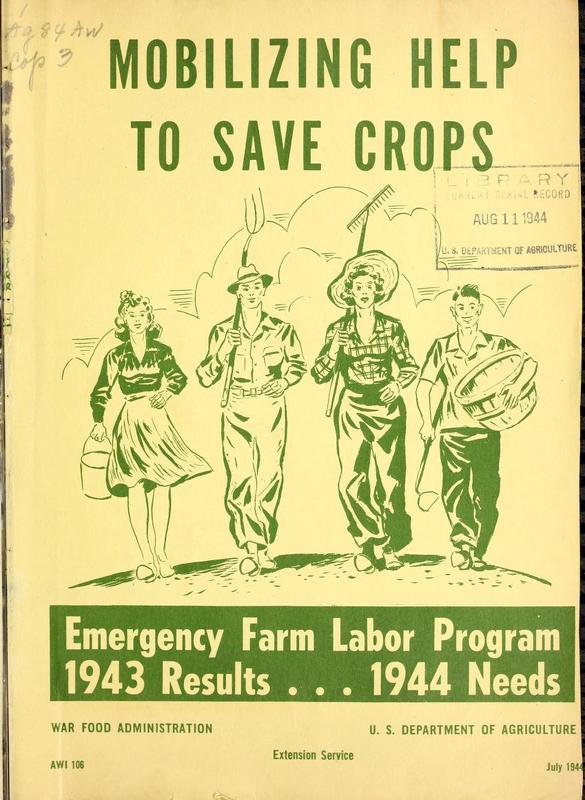Mobilizing Help to Save Crops: Emergency Farm Labor Program: 1943 Results...1944 Needs
Title
Mobilizing Help to Save Crops: Emergency Farm Labor Program: 1943 Results...1944 Needs
Subject
victory gardens
Excerpt
Progress of the war continues to drain manpower from the farms. Even more emergency farm labor will be required to insure a continuous food supply.
At least 4,000,000 workers are needed in 1944 to supplement the efforts of the regular farm labor force, composed of farmers, their families, and hired hands.
A large number of workers are being imported from foreign countries. But these and other unusual sources will supply only about 200,000 workers.
The remaining 3,800,000 must be mobilized in local communities. Men and women, boys and girls from all walks of life will be needed in practically every part of the country at some time during the season.
Of the 4,000,000 emergency workers needed, about 1,200,000 will be teen-age youth from towns and cities. Another 800,000 will be women — stenographers, store clerks, teachers, college girls, housewives. In addition, many business and professional men will spend half days, weekends, or vacation weeks in farm work.
The county agent cannot do the recruitment, placement, and training job alone. The aid of local farm labor advisory committees, neighborhood leaders, schools, churches, service clubs, defense councils, youth organizations, women's clubs, civic organizations, newspapers, radio stations, and Federal, State, and local agencies is essential.
Rural-urban teamwork got results in 1943
It can do the bigger job in 1944!
At least 4,000,000 workers are needed in 1944 to supplement the efforts of the regular farm labor force, composed of farmers, their families, and hired hands.
A large number of workers are being imported from foreign countries. But these and other unusual sources will supply only about 200,000 workers.
The remaining 3,800,000 must be mobilized in local communities. Men and women, boys and girls from all walks of life will be needed in practically every part of the country at some time during the season.
Of the 4,000,000 emergency workers needed, about 1,200,000 will be teen-age youth from towns and cities. Another 800,000 will be women — stenographers, store clerks, teachers, college girls, housewives. In addition, many business and professional men will spend half days, weekends, or vacation weeks in farm work.
The county agent cannot do the recruitment, placement, and training job alone. The aid of local farm labor advisory committees, neighborhood leaders, schools, churches, service clubs, defense councils, youth organizations, women's clubs, civic organizations, newspapers, radio stations, and Federal, State, and local agencies is essential.
Rural-urban teamwork got results in 1943
It can do the bigger job in 1944!
Creator
War Food Administration
U.S. Department of Agriculture
Date
1944
Relation
AWI: Number 106
File(s)
Mobilizing Help to Save Crops Cover.jpg
(image/jpeg)
Mobilizing Help to Save Crops 1.jpg
(image/jpeg)
Mobilizing Help to Save Crops 2.jpg
(image/jpeg)
 An official website of the United States government.
An official website of the United States government.




